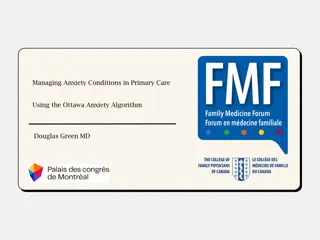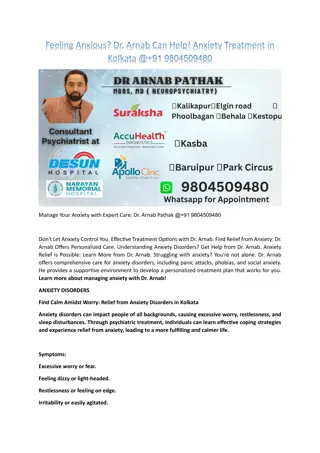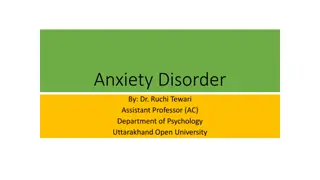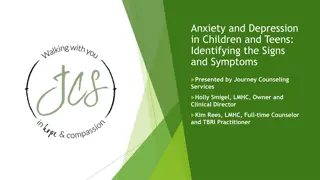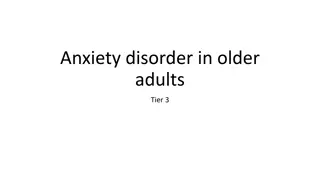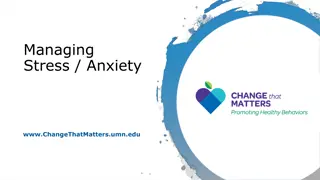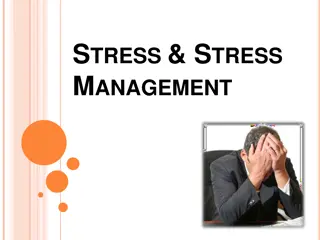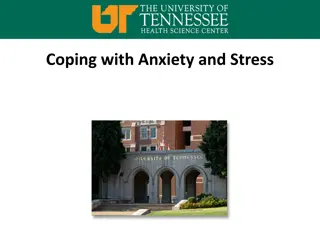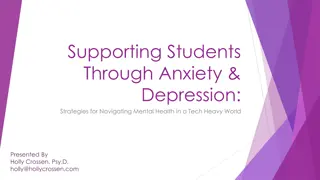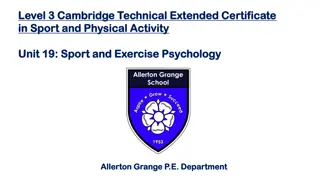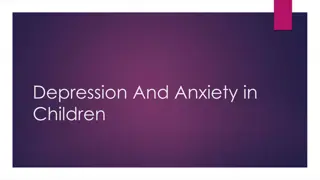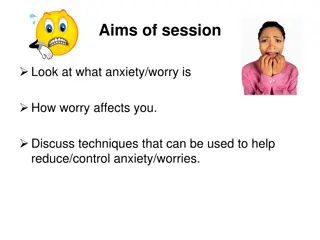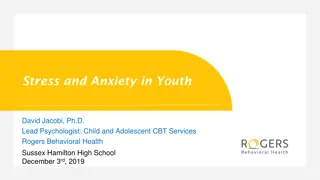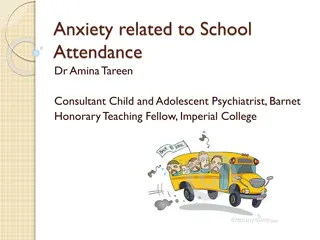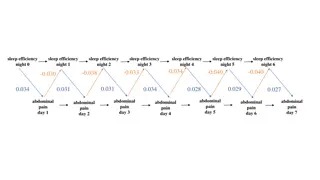
Impact of Mental Health on Individuals and Students
Explore the profound effects of mental health on individuals and students, covering topics such as anxiety, depression, self-harm, addiction, treatment, and the alarming statistics related to mental illness in various settings. Learn about the challenges faced by law enforcement and the concerning rise of mental health disorders in youth, along with the significant financial costs associated with mental health services and the growing importance of addressing these issues.
Download Presentation

Please find below an Image/Link to download the presentation.
The content on the website is provided AS IS for your information and personal use only. It may not be sold, licensed, or shared on other websites without obtaining consent from the author. If you encounter any issues during the download, it is possible that the publisher has removed the file from their server.
You are allowed to download the files provided on this website for personal or commercial use, subject to the condition that they are used lawfully. All files are the property of their respective owners.
The content on the website is provided AS IS for your information and personal use only. It may not be sold, licensed, or shared on other websites without obtaining consent from the author.
E N D
Presentation Transcript
How Mental Health Effects Us and Our Students Larry Scott lscott2@kenton.k12.ny.us
Current State of Mental Health General Characteristics of Anxiety & Depression III. Depression IV. Anxiety Self-Harm & Suicide VI. Addiction VII. Mental Health Treatment/Intervention I. II. V.
North of NYC (over a 5 year period) 47% of people killed by police suffered from a mental illness or were emotionally disturbed 56% of NYS prison population have a mental health problem including substance abuse (5x the rate of general public) 8,000 inmates are cared for by NYS Office of Mental Health About 17% of U.S. prison population have mental illness (3x the rate of the general public)
Mentally ill are more likely to be victims of crime, than criminals, and they are more likely to be harmed by police, than harm police Law enforcement have become primary providers for those with serious mental illness Cuts, consolidations, and closings in mental health continue In 1955 the U.S. had 558,000 beds for mentally ill; today we have about 40,000
The number of poor in the entire Buffalo Niagara metropolitan area grew from 120,861 in 1970 to 162,917 in 2011 52 percent of this area s poor reside in the suburbs Mobile Safety-Net Team (John R. Oishei Foundation): Free/reduced lunch in Ken-Ton (#1): 27% in March of 2001 compared to 41% in March of 2013 Ken-Ton School District is the largest human service of 38 agencies
Question #4 CDC (2012): About 20% of American youth (aged 3 17) suffer from a mental health disorder (ADHD, anxiety, depression, and conduct problems) ADHD= 6.8% Conduct Problems= 3.5% Anxiety= 3% Depression= 2.1% Autism Spectrum Disorder= 1.1% ADHD diagnosis has jumped 53% in past decade Chronic health problems (i.e. asthma & diabetes) are associated with mental illness in adulthood Question #3 $247 Billion is spent per year for mental health services from medical bills, special education, and juvenile justice Question #2 Suicide has become the 2ndleading cause of death among youth (aged 12-17) behind accidents
Everyone experiences varying emotion and mood, including symptoms of anxiety and depression Emotion is the weather, mood is the climate. (C. Smith) Mood: sustained emotional state which impacts how we respond on a regular basis; becomes more of an internal state, independent of external circumstances Emotion: short-term and more influenced by external factors Mood exists across species; the more developed the species the more intensely mood exists independent of external events Some manage the interaction of mood, personality, and stress well, while it becomes problematic for others
Anxiety & Depression often co-exist and influence each Share a single set of genes, which are also involved in alcoholism Depression: a response to loss; Anxiety: a response to future loss Intervention is needed when anxiety and/or depression interferes with a life function (i.e. work, school, family relationships/functioning .).
Genetics Personality Environmental Neuropsychological
Sherri (13) whose mother has untreated depression and father has untreated bipolar disorder, is having meltdowns in school and failing many subject areas. Sherri lives in a duplex in a poverty stricken and violent neighborhood. Sherri was born premature and was separated from her mother several times until the age of two, due to hospitalizations for medical issues. Last summer, a friend of Sherri s was shot and killed in her neighborhood. Sherri exhibits high irritability and often perceives others as untrustworthy and guilty of mistreating her. A social-emotional assessment indicates that she perceives limited internal control over events in her life. Blood work indicates high levels of the stress hormone, cortisol, which is associated with depression and cognitive deficits.
Brain Plasticity Between approximately 10 to 18 months of age is a critical period of plasticity and shaping of the brain (right frontal lobe) for attachments & emotional regulation Neglect/trauma during this period can negatively shape wiring for attachments & emotional regulation, which can continue into adulthood Limbic System (amygdala, hypothalamus, hippocampus, & thalamus) is involved in emotional regulation
About 19 million Americans suffer chronic depression (over 2 million are children) About 15% will commit suicide 2.3 million suffer from Bipolar Disorder Could be leading cause of death when considering its influence on suicide, substance abuse, heart disease, and other health issues Anger & violence may be symptoms of depression, particularly in males (destructive, but short-term remedy)
Females are 2x more likely to suffer depression, a ratio consistent throughout Western societies Rate of depression is about the same among working and non-working married females Males synthesize serotonin 50% more rapidly than females Males are more likely to have ADHD, autism, and alcoholism Closeted people and single people have a higher rate of depression
Question #5 Leading cause of disability in U.S. for those over the age of 5 and leading cause worldwide (WHO); costs tens of billions yearly in lost productivity Question #6 Women who are pregnant or have just given birth are more likely than anyone else to suffer depression, but least likely to commit suicide Question #7 Poverty & parent depression are highest predictors of child depression Question #8 GLBT are at increased risk for depression and anxiety problems. Suicide is the number 1 cause of death for this group Question #9 Those in poverty represent the highest rate of depression compared to any other class in U.S. Question #10 85 95% of those with serious mental illness are unemployed
Fewer social skills and close relationships Fewer social interactions Limited interest in activities Limited motivation and academic achievement Irritability Limited energy Limited affect Worsened with the presence of learning weaknesses Most challenging during adolescence
There are particular genes involved in serotonin regulation which predispose depression, but whether one suffers depression is dependent on life events/experiences There are three possible gene combinations, one from each parent: short/short, short/long, and long/long A short/short combination with multiple uncontrollable bad life events makes it about twice as likely to suffer from depression than long/long combination
Short/Short High Predisposition 2x more likely to suffer Depression than Long/Long Multiple Uncontrollable Events
Significant episodes of depression alter brain chemistry (i.e. decrease Serotonin receptors) and structure (i.e. hippocampus) With each episode of depression there is an increased 10% risk depression will become chronic and inescapable Early childhood trauma causes major changes to the brain s hippocampus, shrinking it & inhibiting new, long-term memories Depression, high stress, and childhood trauma all cause the release of stress hormone (glucocorticoid)- kills cells in the hippocampus The longer someone is seriously depressed or under high stress the smaller their hippocampus. Antidepressants have been found to increase stem cells that become new neurons in the hippocampus It takes about 3-6 weeks on an antidepressant for new neurons to mature and connect with other neurons
Many studies show that socioeconomic status is the number one predictor of depression Depression is so common in poor communities awareness that an internal problem exists is lacking; perceived the problems are only due to uncontrollable external factors Poverty is highly associated with a learned helplessness & passivity Rate among welfare recipients is about 3x higher
Quality mental health care is lacking most among the poor Investment in addressing mental health needs may be worthwhile, financially and socially The cost of not treating mental illness, may far outweigh the cost of adequately treating it
Depressed mothers greatly influence the likelihood that a child will suffer depression or other emotional / behavioral issues Having a depressed mother is often more detrimental than a schizophrenic mother With a depressed mother, signs of depression can be seen in infants, as early as 3 months: weepy, angry, & aggressive If mother s depression is treated early, children show improvement, reversal becomes more challenging with age
Five potential impacts on childs emotional / behavioral development (Sameroff, A.): Genetics Empathetic mirroring: repeating back what they experience Learned helplessness: giving up on connecting due to lack of parent approval for emotional outreach Role-playing: taking on the illness role to avoid unpleasant things as observed by parent Withdrawal: consequence of seeing no pleasure/meaning in communication with unhappy parent 1. 2. 3. 4. 5.
Anaclitic depression: occurs in second half of the child s first year when separated too much from their mother May develop in failure to thrive starting at age four or five; limited affect & don t bond At age five to six show extreme crankiness, irritability, poor sleeping, and poor eating Low self-esteem, high anxiety, and bed-wetting become common problems
Depressed children usually go on to be depressed adults Occurs in many before puberty, but peaks in adolescence The earlier the onset the more resistance to treatment Early/preventative intervention is critical
Four possible theories: 1. Served an important purpose in pre-human times 2. The stresses of modern life are incompatible with the brains we have evolved. 3. It serves a useful function. 4. It is a secondary result of other characteristics.
Self-Consciousness: high awareness of self, meta- cognition, and awareness of competing cognitive functions (i.e. rational and emotional thinking) makes us unlike any other species Humans have the slowest brain maturation and are most plastic at older ages Humans exhibit significant capacity to regulate emotions Linguistic-Evolutionary Model (Crow, Timothy) mental illness is on a continuous spectrum and is determined by difference in intensity of symptoms
High Intensity Moderate Intensity Low Intensity
10 20% Americans suffer from Anxiety Disorder About of those with true anxiety disorders develop major depression within 5 years Worsens with time if untreated Anxiety is often overlooked, misdiagnosed as ADHD, left untreated, and sometimes worsened when misdiagnosed Anxiety is difficult to detect- internal, not easily observed Children and self-awareness Medication
When doing something new When uncertain about plans When there what ifs When you have to perform When doing something scary
The opposite of peace and feeling safe Curse of sensitivity & empathy: a capacity for feeling deeply, including emotional pain, which both can be helpful and hindering. Often obsessive thinkers without compulsive tendencies Anticipatory anxiety
Strong episodes of anxiousness and panicky feelings Feelings of bewilderment and unreality Feelings of depression and hopelessness Restless feelings, insomnia, sleeping too much Picking at self or objects Uncontrollable bouts of anger/crying Obsessive-compulsive tendencies Withdrawing Frightening, gruesome thoughts (diversion from conflict)
Temperament: inborn, biological ways of responding emotionally/behaviorally in infancy and early childhood Personality: outcome of an interaction of biological traits with social and personal experiences S. Cain (2013): Quiet
Longitudinal study by Jerome Kagan, 1989 (500 infants): Exposed 4 month-olds to novel experiences: strange visuals, loud noise, and odd smells 20% were high reactive cried vigorously, pumped arms and legs and had higher activity in amygdala, higher heart rate, more eye dilation, more cortisol in saliva Many in this group developed to be introverted, sensitive, deep processors, and highly attentive to others / environment / experiences Sensitive to sensory stimuli and challenges, such as marital tension, death of a parent, and abuse S. Cain (2013): Quiet
Prone to be shy and experience anxiety and depression Usually very empathetic, caring, and cooperative, while easily upset with injustice, cruelty, and irresponsibility Amygdales remained more reactive to novel stimuli With good parenting and stable home life they often have fewer emotional problems and more social skills S. Cain (2013): Quiet
Experiencing severe panic attacks can be debilitating Often develop from life events where there is a loss of security or perceived loss of security Most difficult factor- it is uncontrollable, feelings occur for absolutely no reason About 1/3 of panic attacks related to depression occur during deep, dreamless sleep
Cognitive Symptoms: I m going to have a heart attack. I m about to die. I can t breathe properly. I m going to suffocate. I m about to pass out. I m going to lose control and go crazy.
Pounding heart Chest pain / tightness Tight, tense muscles Shortness of breath Feeling unreal or detached Nausea / dizzy Trembling Hot / cold flashes Numbness / tingling
What is the difference between fear and danger? When is it smart and useful to be scared?
Anxiety is one of the most basic emotions found in almost all animal species Is a response to danger or threat- perceived or real It s primary purpose is to protect us, not harm us Fight/Flight/Freeze response Sympathetic nervous system releases energy to respond to threat Parasympathetic nervous system restores the body to normal function
Control Anxiety Anxiety Control
People with high anxiety lock onto worry and can t let go Their brains are haunted with horrific scenarios that present as quite real and can t be ignored Norepinephrine and serotonin are neurotransmitters which play a role in anxiety Locus coeruleus controls norepinephrine production & the lower bowel
Brain chemistry changes = feeling unpleasant Perceive threat/fear Do something to feel better: avoid, seek reassurance ask a lot of questions, etc Dr. K. Morrow
Obsessive-Compulsive Disorder (OCD) can be most severe with frequent worrying about harm to self and/or loved ones Excessive fear of health is common- with frequent scanning of body for symptoms & doctor visits OCD often worsens with time, slowly shaping brain structures/functioning Certain thoughts continue even when it is known that they are meaningless
The brain of OCD does not move or transition easily. It becomes locked. 3 major areas are hyperactive in those who suffer from OCD: Orbital frontal cortex: the more obsessive the more activity in this area Cingulate gyrus: seems to play a role in triggering the sense of impending dread which then activates physiological responses (pain in stomach, pounding heart, etc ) Caudate nucleus: plays a role in transitioning our thoughts 1. 2. 3. OCD can be inherited, but infections can swell the caudate nucleus leading to OCD symptoms
Dr. Jeffery Schwartz (Brain Lock) and his research have discovered much about the brain s role in OCD Uses a form of psychotherapy to restructure the brain with a success rate of about 80% when combined with an antidepressant medication The 3 major parts of the brain which are hyperactive & locked begin to function normally and separately, relieving the brain lock Uses 2 major methods: 1. Identify & accept that an obsessive worry is a symptom of OCD & not something else (i.e. chronic disease) 2. Focus on something desirable & pleasurable (about 30 minute intervals) when faced with the obsessive thoughts
With obsessions & compulsions the more you do it, the more desire to do it; the less you do it, the less you desire to do it Intensive therapy which compels patients to think or do something pleasurable triggers dopamine release, rewarding new brain activity and growth of healthy neural circuitry and connections One needs to be distracted and change the channel for a period of time when experiencing obsessions & compulsions Anxious feelings will remain for some time (may initially increase) but by changing behavior & how one responds, brain restructuring can occur & with time anxiety will reduce

